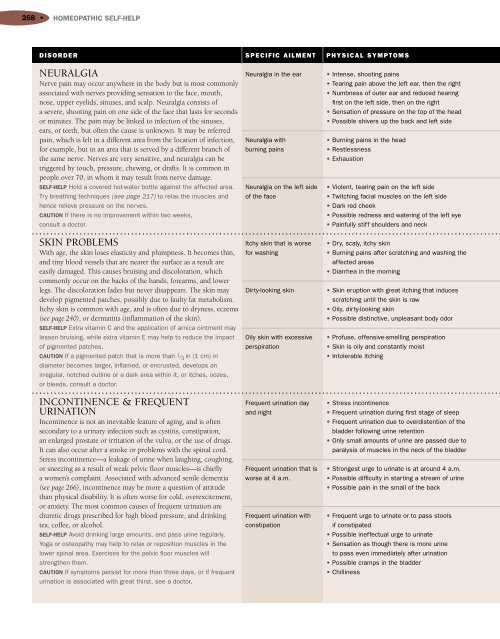Encyclopedia of Homeopathy
Encyclopedia of Homeopathy
Encyclopedia of Homeopathy
You also want an ePaper? Increase the reach of your titles
YUMPU automatically turns print PDFs into web optimized ePapers that Google loves.
268 • HOMEOPATHIC SELF-HELPDISORDERNEURALGIANerve pain may occur anywhere in the body but is most commonlyassociated with nerves providing sensation to the face, mouth,nose, upper eyelids, sinuses, and scalp. Neuralgia consists <strong>of</strong>a severe, shooting pain on one side <strong>of</strong> the face that lasts for secondsor minutes. The pain may be linked to infection <strong>of</strong> the sinuses,ears, or teeth, but <strong>of</strong>ten the cause is unknown. It may be referredpain, which is felt in a different area from the location <strong>of</strong> infection,for example, but in an area that is served by a different branch <strong>of</strong>the same nerve. Nerves are very sensitive, and neuralgia can betriggered by touch, pressure, chewing, or drafts. It is common inpeople over 70, in whom it may result from nerve damage.SELF-HELP Hold a covered hot-water bottle against the affected area.Try breathing techniques (see page 217) to relax the muscles andhence relieve pressure on the nerves.CAUTION If there is no improvement within two weeks,consult a doctor.SKIN PROBLEMSWith age, the skin loses elasticity and plumpness. It becomes thin,and tiny blood vessels that are nearer the surface as a result areeasily damaged. This causes bruising and discoloration, whichcommonly occur on the backs <strong>of</strong> the hands, forearms, and lowerlegs. The discoloration fades but never disappears. The skin maydevelop pigmented patches, possibly due to faulty fat metabolism.Itchy skin is common with age, and is <strong>of</strong>ten due to dryness, eczema(see page 240), or dermatitis (inflammation <strong>of</strong> the skin).SELF-HELP Extra vitamin C and the application <strong>of</strong> arnica ointment maylessen bruising, while extra vitamin E may help to reduce the impact<strong>of</strong> pigmented patches.CAUTION If a pigmented patch that is more than 1 / 3 in (1 cm) indiameter becomes larger, inflamed, or encrusted, develops anirregular, notched outline or a dark area within it, or itches, oozes,or bleeds, consult a doctor.INCONTINENCE & FREQUENTURINATIONIncontinence is not an inevitable feature <strong>of</strong> aging, and is <strong>of</strong>tensecondary to a urinary infection such as cystitis, constipation,an enlarged prostate or irritation <strong>of</strong> the vulva, or the use <strong>of</strong> drugs.It can also occur after a stroke or problems with the spinal cord.Stress incontinence—a leakage <strong>of</strong> urine when laughing, coughing,or sneezing as a result <strong>of</strong> weak pelvic floor muscles—is chieflya women’s complaint. Associated with advanced senile dementia(see page 266), incontinence may be more a question <strong>of</strong> attitudethan physical disability. It is <strong>of</strong>ten worse for cold, overexcitement,or anxiety. The most common causes <strong>of</strong> frequent urination arediuretic drugs prescribed for high blood pressure, and drinkingtea, c<strong>of</strong>fee, or alcohol.SELF-HELP Avoid drinking large amounts, and pass urine regularly.Yoga or osteopathy may help to relax or reposition muscles in thelower spinal area. Exercises for the pelvic floor muscles willstrengthen them.CAUTION If symptoms persist for more than three days, or if frequenturination is associated with great thirst, see a doctor.SPECIFIC AILMENTNeuralgia in the earNeuralgia withburning painsNeuralgia on the left side<strong>of</strong> the faceItchy skin that is worsefor washingDirty-looking skinOily skin with excessiveperspirationFrequent urination dayand nightFrequent urination that isworse at 4 a.m.Frequent urination withconstipationPHYSICAL SYMPTOMS• Intense, shooting pains• Tearing pain above the left ear, then the right• Numbness <strong>of</strong> outer ear and reduced hearingfirst on the left side, then on the right• Sensation <strong>of</strong> pressure on the top <strong>of</strong> the head• Possible shivers up the back and left side• Burning pains in the head• Restlessness• Exhaustion• Violent, tearing pain on the left side• Twitching facial muscles on the left side• Dark red cheek• Possible redness and watering <strong>of</strong> the left eye• Painfully stiff shoulders and neck• Dry, scaly, itchy skin• Burning pains after scratching and washing theaffected areas• Diarrhea in the morning• Skin eruption with great itching that inducesscratching until the skin is raw• Oily, dirty-looking skin• Possible distinctive, unpleasant body odor• Pr<strong>of</strong>use, <strong>of</strong>fensive-smelling perspiration• Skin is oily and constantly moist• Intolerable itching• Stress incontinence• Frequent urination during first stage <strong>of</strong> sleep• Frequent urination due to overdistention <strong>of</strong> thebladder following urine retention• Only small amounts <strong>of</strong> urine are passed due toparalysis <strong>of</strong> muscles in the neck <strong>of</strong> the bladder• Strongest urge to urinate is at around 4 a.m.• Possible difficulty in starting a stream <strong>of</strong> urine• Possible pain in the small <strong>of</strong> the back• Frequent urge to urinate or to pass stoolsif constipated• Possible ineffectual urge to urinate• Sensation as though there is more urineto pass even immediately after urination• Possible cramps in the bladder• Chilliness
















